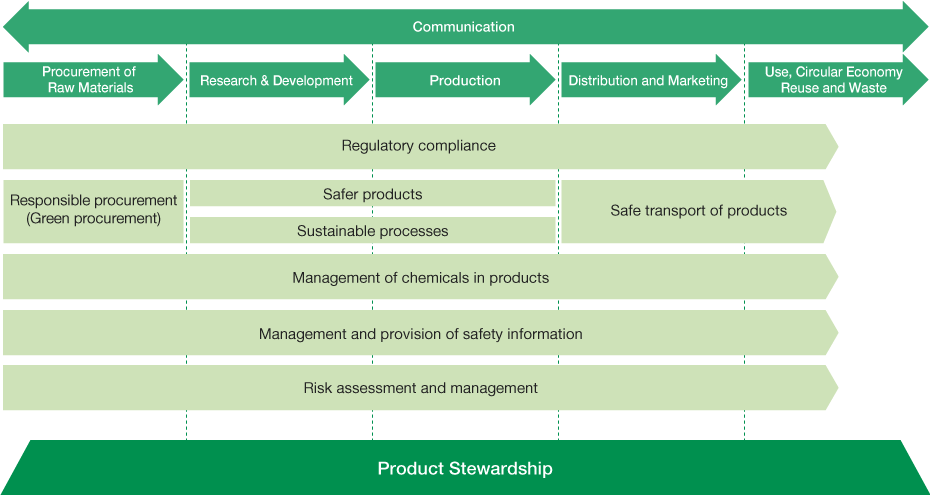Product Stewardship
Mitsubishi Chemical Corporation
Basic Policy
It is the responsibility of Mitsubishi Chemical (MCC) to cooperate with stakeholders to protect the environment and the health and safety of people at every stage of its products’ life cycles (encompassing the procurement of raw materials, research & development, production, distribution and marketing, and use, circular economy reuse and waste).
In line with its mission of realizing KAITEKI and as part of its responsible care activities, MCC strives to implement product stewardship initiatives, which are part of the foundation of responsible care, through safety management at every stage of its products’ life cycles. In addition, we proactively provide information about product risks to stakeholders and engage in dialogue to ensure proper management. Through such efforts, we work to ensure appropriate end use of our products from the perspectives of quality assurance and security export control.

- ■ Communication
- Communicate with stakeholders, both internal and external, including customers, regulators and the public, about the safe and secure use and potential hazards of the products we manufacture and any associated risks to ensure that our products are handled appropriately at each stage of their life cycles.
- ■ Procurement of Raw Materials
- Set high expectations for the health, safety, security and environmental performance and social responsibility of suppliers and obtain information related to the safety of procured raw materials from business partners.
- ■ Product Development
- Develop products that have no risk or minimize the risk of adverse health, safety and environmental impacts throughout their entire life cycles and deliver added value, and retain development information for security.
- ■ Production
- Protect the health and safety of our employees and the local community by improving production processes and promoting a corporate culture that places the highest priority on human health and safety, and minimize our environmental footprint by avoiding chemical pollution, reducing energy consumption, supporting recycling and ensuring proper disposal of waste from the products we manufacture, and keep production information for security.
- ■ Distribution and Marketing
- Provide accurate and detailed information related to product safety and handling to business partners involved in the storage, transport, distribution, marketing and use of our products; and implement appropriate responses, including the provision of additional support to improve product handling practices, as needed.
- ■ Use, Circular Economy Reuse and Waste
- Work with our business partners to provide relevant information to ensure safe and secure use and to support the recycling, reuse and proper disposal of our products.
These initiatives are in line with the Strategic Approach to International Chemicals Management (SAICM).*1 Along with process safety and disaster prevention, occupational safety and health, environmental conservation, chemical and product safety, and logistics safety, these initiatives are aimed at realizing KAITEKI through risk-based chemicals management across product life cycles.
- *1Strategic Approach to International Chemicals Management (SAICM): A strategic approach to international chemicals management adopted by the International Conference on Chemicals Management (ICCM) and approved by the United Nations Environment Programme (UNEP) in 2006.
